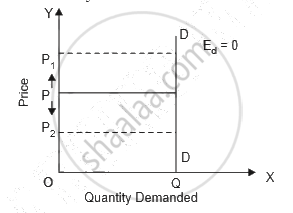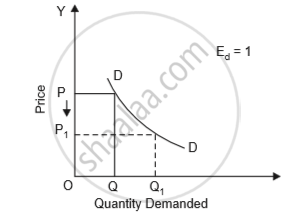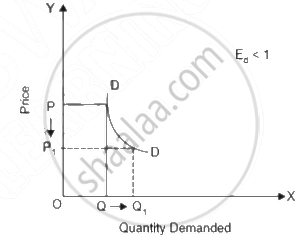Advertisements
Advertisements
प्रश्न
Write an explanatory answer :
What is the price elasticity of demand? Explain the types of price elasticity of demand.
उत्तर
Price Elasticity of Demand :
The variation in demand in response to a variation in price is called price elasticity of demand. It may also be defined as the ratio of the percentage change in demand to the percentage change in the price of a particular commodity
According to Samuelson :
"Price elasticity is a concept for measuring how much the quantity demanded response to changing the price.” It is clear from the above definitions that elasticity of demand is a technical term that describes the responsiveness of change in the quantity demanded to a fall or rise in its price. In other words, it is the ratio of the percentage change in quantity demanded of a commodity to a percentage change in price.
Types of Price Elasticity of Demand Degrees of Elasticity of Demand are :
(i) Infinite/Perfectly Elastic Demand
When a change in price leads to an infinite change in quantity demanded, it is known as infinite elastic demand. When demand is infinitely elastic, the demand curve is a horizontal straight line parallel to X-axis. Symbolically, Ed =∞ Perfectly elastic demand is only a theoretical possibility.
Infinite/Perfectly Elastic Demand Curve
(ii) Perfectly Inelastic Demand
Irrespective of change in price, when demand remains the same, it is called perfectly inelastic demand. For example: as shown in the figure below, at price OP demand is OQ, whereas at price OP1 (Higher) and OP2 (Lower) the demand is OQ only. It means demand does not change at all. When demand is perfectly inelastic, the demand curve is represented by a vertical straight line parallel to Y-axis as shown in the diagram. Symbolically, Ed=0. In practice, such situation occurs occasionally, such as demand for salt.
Perfectly Inelastic Demand Curve

(iii) Unitary Elastic Demand
When a change in price leads to proportionate change in quantity demanded then demand is unitary elastic. For example: if the price falls by 50%, the demand will rise by 50%. In the figure, the change in price is PP1 and the change in demand is QQ1. Both the changes are proportional to each other. So the demand curve DD shows unitary elastic demand. Symbolically, Ed = 1.
Unitary Elastic Demand Curve

In this type, the slope of the demand curve is flatter.
(v) Relatively Inelastic Demand
When a change in price leads to less than proportionate change in quantity demanded, the demand is relatively inelastic. For example: if the price falls by 50%, the demand will rise by 25%, i.e., less than the percentage change in price. In the above figure, the change in price is from OP to OP1 is greater than change is demand from OQ to OQ1.
Relatively Inelastic Demand Curve

Therefore, DD is the demand curve which represents inelastic demand. Symbolically, Ed < 1. The slope of the demand curve is steeper.
APPEARS IN
संबंधित प्रश्न
What are the types of Elasticity of Demand.
Income elasticity of demand.
The demand for good rises by 20 percent as a result of all in its price. Its price elasticity of demand is (−) 0.8. Calculate the percentage fall in price.
How is price elasticity of demand affected by:
(i) Number of substitutes of available for the good.
(ii) Nature of the good.
Explain the relationship between
(i) Prices of other goods and demand for the given good.
(ii) Income of the buyers and demand for a good.
Write short answer for the following question :
Explain the Fectors Determinants of Elastacity of Demand?
State whether the following statements are True or False with reasons:
The demand of a rich person is elastic.
Under monopoly, price elasticity of demand is ______
______ refers to the effects of a change in price of commodity X on demand for commodity Y when quantity demanded.
Which of the following points are related with effective demand?
Which of the following influence price elasticity of demand?
Which of the following statement is true?
When the demand of a commodity is inelastic.
As we move along a downward sloping straight-line demand curve from left to right, price elasticity of demand ______
______ refers to the minimum price, fixed by the government, which is above the equilibrium price.
When price falls with rise in output, TR is ______ when MR is zero
Statement 1: The supply of the commodity can also decrease when the price remains constant.
Statement 2: Due to rise in price of factor of production or inputs.
The supply curve of good shifts to the right when the price of other goods ______.
Which of the following factor affects the individual demand?
When the actual price of a commodity is less than the equilibrium price, then equilibrium price ______
Which of the following statements is true?
If the price of a commodity and total expenditure on that commodity change in the same direction, the price elasticity of demand will be ______.
When can the income elasticity of demand be negative?
If the price elasticity of demand for a commodity is 2 and the percentage change in price is 5, the percentage change in quantity demanded will be ______.
If the price hike in the market is about 10% and this leads to the fall in the quantity demanded by 12%, calculate the price elasticity of demand. Mention the degree of price elasticity of demand.
